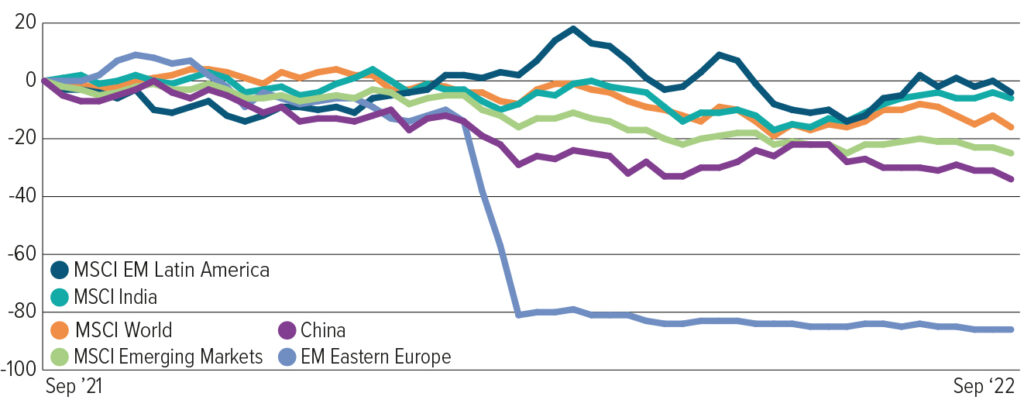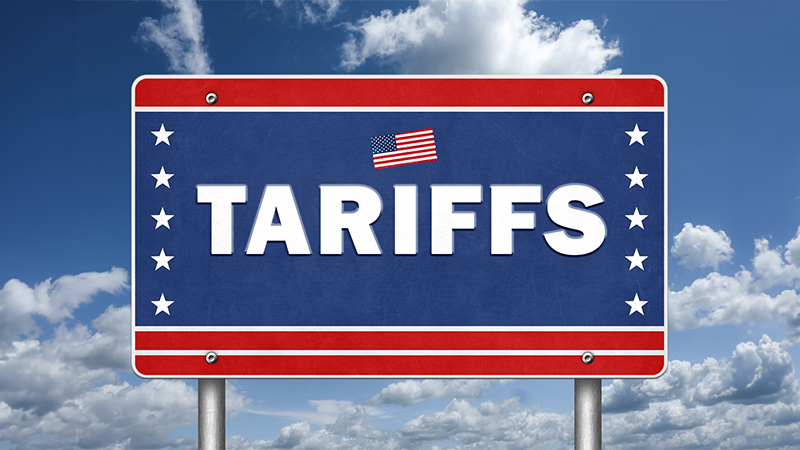It has been a tough year for equity markets – and a tougher one still for emerging market equity markets. Last year, the asset class were tipped to benefit from the post-pandemic take-off in demand, with even a post-pandemic reversion to the mean by the global economy seen as disproportionally beneficial to the world’s emerging economies.
To twist an old saying, however – if you want to make the gods laugh, show them your investment outlook 12 months out. There has since, of course, been a whole toolbox-worth of spanners thrown in the works, from war in Ukraine to China facing ongoing difficulties due to Covid-induced supply chain bottlenecks and a crisis-ridden property sector.
That said, India, frontier markets, and Middle East and North Africa performed well over 2021, while India and Latin America have outperformed the MSCI World Index over 12 months. Nevertheless, the largest part of the Emerging Markets index is China and, saving a strong summer bounce, it continues to struggle – though not as much as emerging Europe, for obvious reasons.
MSCI percentage growth

This volatility is reflected in investor sentiment. While net flows into the IA Emerging Markets sector have been around £2.3bn over three years, net outflows over the three months to end-August are £1.9bn. Nevertheless, this is hardly unique to emerging markets, with £4.6bn and £4.7bn being withdrawn from Global and UK All Companies equity funds over the same period.
Lipper global equity percentage growth

Source Lipper. 10 September 2021 – 16 September 2022
Looking at diversified emerging market funds – Lipper’s emerging market equity classification – three-year returns to the end of August range from 46.7% to -28.6%, while one-year returns go from 17.2% to -47%, although these two datapoints are themselves something of outliers.
The top-performing fund over the year – the Fiera Oaks EM Select Fund – has a country allocation very different to the pack, with Saudi Arabia and Vietnam making up more than 36%; as does second-placed BNY Mellon Emerging Income, which has only a 7.7% allocation to China. The tilt towards income stocks will no doubt also have served the latter well over the past year, which investors picking up on this area in their asset allocations more broadly.
Similarly, the largest exposure to St James’s Place Emerging Markets Equity – top-placed over three years, as the table below shows – is 22.7% to the Philippines. So, it pays to be different … at least to some extent, as the Lipper Global Equity Emerging Markets classification average has underperformed the MSCI Emerging Markets Index every year since 2017 in sterling terms.
| Fund name | % growth | % growth | Capital preservation | |
| One year | Three years | |||
| 1 | St. James’s Place Emerging Markets Equity L Acc | -20.41 | 46.66 | 2 |
| 2 | BNY Mellon Global Emerging Markets B Acc | -14.17 | 44.64 | 4 |
| 3 | FP Carmignac Emerging Markets GBP A Acc | -15.29 | 40.66 | 2 |
| 4 | BNY Mellon Global Emerging Markets A EUR | -14.48 | 34.31 | 4 |
| 5 | MS INVF Emerging Leaders Equity A USD | -22.22 | 33.85 | 1 |
| 6 | ACMAF Aubrey Global Em Mkts Opps Fd RC1 GBP Cap | -15.35 | 30.94 | 2 |
| 7 | Pacific North of South EM All Cap Equity Z GBP Acc | -6.78 | 29.96 | 4 |
| 8 | Invesco Global Emerging Markets (UK) Acc | -3.8 | 28.8 | 4 |
| 9 | RAM (Lux) SF-Emerging Markets Eqs F USD Cap | -1.64 | 26.96 | 5 |
| 10 | Invesco Emerging Markets Equity Fund A-AD | -4.06 | 26.65 | 4 |
Note: Data to 31/08/22; Capital preservation is the Latest Lipper Leader score, 3-year value
Source Lipper
The above table also includes the Lipper score for capital preservation, with 1 being the lowest and 5 the highest. There is only one fund in the table with a 5, although a further five are rated 4. Given the bleak outlook over the coming months, the ability to preserve capital will likely have an enhanced importance. The market may have fallen considerably but it can still fall more.
Silver linings
There are some silver linings, however – for example, JP Morgan analysts reckon that, while Chinese equities are heavily out of favour, “the Chinese stockmarket has fallen 50% from last year’s peak and now trades at an attractive valuation. The near-term outlook looks especially tough as the government grapples with Covid-19 outbreaks that are exacerbating weakness in the economy. But for long-term investors, these valuations look interesting.”
And, despite fears that last year’s Indian outperformance was due to a plethora of IPOs that has since petered out, there are still hopes the country will be able to deliver further gains, driven by the spending power of a growing middle class.
Such hopes are highly conditional: while there is some indication emerging markets’ reliance on western demand – and therefore western economic health – is weakening, it is still a major factor. And, as the west slides into recession, this is likely to be amplified in emerging markets.
There is a flipside to this, of course – when the global economy rebounds, emerging markets generally rebound harder, and will be a good place to be. While individual countries have shown their ability to break from the pack, as we have seen above, knowing which ones, when, and why is for most mortals no better than a game of chance.
Favouring diversification
The difficulty of determining where the next round of outperformance is coming from militates in favour of the ongoing popularity of diversified emerging market funds in much the same way as we have seen diversified global equity funds gain traction with investors over recent years.
That is likely to persist – and for good reason – but it also indicates that, while the label has a utilitarian function, it pulls together a very different group of countries. For that reason, it seems unlikely we will see an emerging market sub-theme, such as ‘BRICs’ gain traction any time soon.
Emerging markets have traditionally come with greater volatility and, for those prepared to ride this out over the long term, a higher return. What is more, their increasing importance in the world economy and the greater choice on offer should bode well. Emerging markets are also underrepresented in investment terms. They constitute 11% of the MSCI All Country World index, but account for 34% of the world’s nominal GDP in US dollars and 46% in purchasing-power-parity terms, according to the IMF.
That, of course, is the long-term case and, in the long term, as Keynes reminded us, we are all dead. Plus you can’t take it with you – though many historic EM leaders, from Emperor Qin Shi Huang to Pharoah Khufu have certainly tried. In the nearer term, entry points need careful consideration.
Dewi John is head of research UK & Ireland at Refinitiv Lipper











